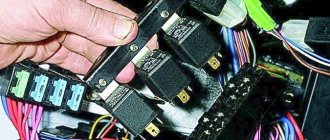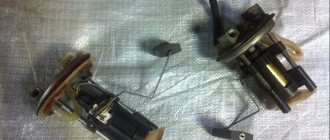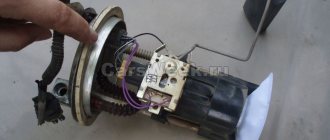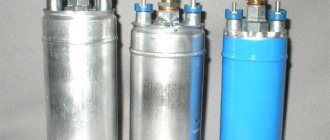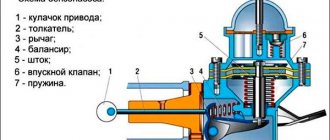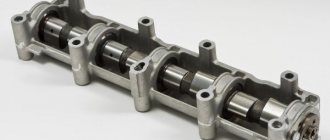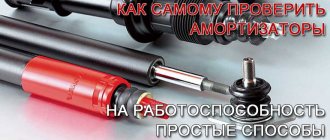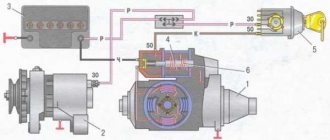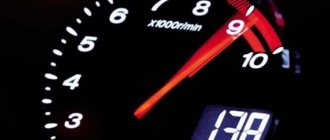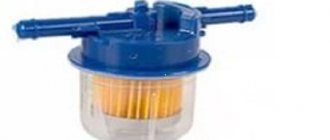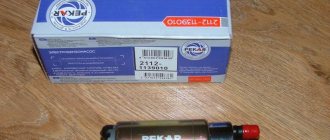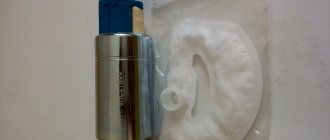Modern passenger cars are equipped with electric vibration pumps. Unlike mechanical predecessors, installed near the engine, the new units are immersed inside the gasoline tank, where direct access is limited. In order to independently solve problems associated with interruptions in the fuel supply, you need to be able to distinguish the signs of a fuel pump malfunction from problems with other elements of the fuel system.
Gasoline supply problems - common symptoms
Malfunctions of the fuel supply system are conventionally divided into 2 categories:
- The combustible mixture is not supplied to the cylinders at all.
- Gasoline is supplied intermittently or under insufficient pressure.
In the first case, the engine does not start and does not engage the starter during rotation, that is, it does not show signs of life. In such a situation, it is always easier to determine the cause of the breakdown.
When insufficient fuel enters the cylinders, the following symptoms appear:
- starting the power unit “from cold” is very difficult, the engine seizes and “sneezes”, it starts in 3–10 attempts;
- idling is unstable, the engine “troubles”;
- dynamic acceleration becomes impossible - a sharp opening of the throttle causes a long dip and deceleration;
- when the driver releases the accelerator pedal, the engine often stalls;
- The car has difficulty climbing hills and accelerates slowly when fully loaded.
The cause of the above phenomena may be a malfunction of the fuel pump or other elements of the system, and the primary symptoms are almost the same. To carry out an accurate diagnosis, you need to understand how the car's power system works.
Car won't start after replacing fuel pump
Sometimes, after installing a new pump, the car cannot be started. There may be several reasons for this problem.
A defective product has been installed. It needs to be replaced.
The fuel inlet and outlet pipes are not connected correctly.
The power plug is not connected correctly.
The terminal contacts have oxidized. They need to be cleaned.
Proper connection of wires and fuel supply pipes guarantees proper operation of the fuel pump
The fuel pump is the main element of the fuel supply system. Any malfunction leads to the impossibility of further operation of the vehicle. You should pay attention to all symptoms of decreased performance of the mechanism, immediately identify them and take appropriate measures. Good luck on the roads!
A car fuel pump is a device designed to provide an uninterrupted supply of fuel to the installation in which the fuel mixture is formed. Even the slightest malfunction leads to interruptions in the operation of the engine, and in the event of more serious problems, you simply will not start it.
In this article we will look at situations where the gas pump does not pump fuel at all, or pumps it, but not in the amount required by the power unit for normal operation. We will also try to understand the possible causes of this or that malfunction of the fuel supply device and discuss methods for eliminating them independently using the example of domestically produced cars carburetor VAZ-2109 and injection VAZ-2114.
Design and operation of fuel supply
The system that provides the engine with the required amount of gasoline operates according to the following algorithm:
- After turning on the ignition, the electric fuel pump starts, raising the pressure in the line after itself to a certain level. The electrical power supply circuit of the unit is protected by a fuse.
- The fuel pressure regulator (common abbreviation - RDT) is located on the line after the pump and limits the upper pressure threshold, dumping excess fuel back into the tank through a separate pipeline.
- When the crankshaft is rotated by the starter and the engine continues to operate, fuel enters the fuel rail, mixes with air and is directed to the injectors built into each cylinder. The amount of mixture supplied to the combustion chambers is controlled by an electronic unit.
- On the way to the fuel rail, gasoline goes through 2 stages of filtration. The first is a mesh installed in the tank on the suction pipe of the pump, the second is a fine filter on the gas supply line.
Reference. In various car models, 2 schemes are used for installing the RTD and laying the return pipeline - in the engine compartment or directly in the gas tank. In the first case, the standard fuel pressure in the system is 2.7...3.0 Bar, in the second - 3.8...4 Bar.
A common mistake made by ignorant car enthusiasts: if the combustible mixture does not enter the cylinders, then the fuel pump is definitely not working. Knowing the design of the fuel supply, we can assume other problems:
- the protective fuse in the electrical circuit has blown, the pump is in good working order, but does not receive power;
- the primary or secondary filter is clogged (sometimes both at once), fuel flows in small quantities or does not flow at all;
- the pressure regulator has become unusable, dumping the lion's share of the fuel back into the tank, the engine gets nothing;
- One or more injectors have failed.
To accurately determine the source of the problem, you need to check the operation of the electric fuel pump and other elements. It is not necessary to go to a service station - diagnostic work can be carried out in your own garage.
VT with electric drive
Long-lasting operation, ease of manufacture and greater efficiency can be obtained by using an electric fuel pump, which is controlled by a special relay. It allows you to create a pressure in the range of 0.3-0.4 MPa (in engines with direct injection - up to 0.7 MPa), which exceeds the capabilities of a mechanical HP. The device largely depends on where the fuel pump is located: in the tank or in the engine compartment. But the operating principle of all VTs of this type can be considered identical. The vast majority of modern cars use a submersible fuel pump, which is located in the tank. Although this is fraught with small mechanical losses and vulnerability associated with the long length of the fuel line, the pump receives much better cooling.
During operation, the fuel washing the housing and passing through the electric motor removes a significant part of the heat. This is why driving with an almost empty tank affects the resource so much.
Device
An electric fuel pump consists of two parts: an electric drive (represents a conventional electric motor) and a pump part (pumps fuel from the fuel intake). Submersible pumps are placed in a single housing with a mesh that performs rough fuel cleaning.
Depending on the design of the intake mechanism, there are several types of pump parts:
- roller pump. Fuel is supplied by rotating a rotor with movable rollers. As the space between the roller and the rotor increases, a vacuum is created in the free space, which is filled with gasoline. With further rotation of the rotor, the space decreases, which allows pressure to be created and fuel to be supplied through the exhaust channel;
- gear fuel pump. The principle of operation is similar to the previous view, but changes in the area of free space occur due to the rotation of the gear;
- centrifugal pump. Fuel injection occurs due to vortex caused by the rotation of the impeller in the housing. The supply and removal of fuel is carried out through the corresponding channels inside the housing.
Operation logic
In cars in which the main life support components of the internal combustion engine are controlled via a CAN bus, the fuel pump receives the command to start from the electronic engine control unit. Before starting the internal combustion engine, it is necessary to create pressure in the fuel line, so immediately after turning on the ignition, the ECU sends a signal to the relay, which turns on the fuel pump. In some cars, power is supplied to the relay and the fuel pump is turned on when the driver's door is opened. The operating time of the fuel pump in this mode is calculated in seconds, after which the power is turned off. The subsequent start will occur when the starter begins to rotate.
Basic faults, simple diagnostics
The main breakdowns due to which the fuel pump may not work include:
- fuse blown;
- power failure, contact oxidation;
- wear of the brush assembly, as a result of which performance deteriorates, destruction of the commutator, wear of the rotor bushings;
- clogging;
- critical wear of rubbing pairs of roller and gear fuel pumps;
- destruction of the plastic coupling through which the armature shaft of the electric motor is connected to the pump rotor.
To understand why the fuel pump does not work, basic skills in using a multimeter are enough. The presence of power at the VT connector after turning on the ignition will indicate that the fault is in the pump. If power does not come and the fuel pump does not start, then you should check the circuit to the connector, as well as the relay.
Main symptoms of malfunction:
- increase in noise, appearance of extraneous sounds;
- failures when pressing the gas sharply;
- the engine periodically stalls (especially when hot);
- problems with starting.
Relay
One of the most important elements of the fuel injection engine power system is the fuel pump relay. It is used to reduce the load on the on-board network, since the power contacts are controlled by applying a low voltage to the corresponding terminals of the electromagnetic relay. Schematic diagram of connecting a fuel pump.
You can see the principle of operation of the relay, as well as testing methods in the video.
How to check the functionality of the pump?
If the engine is absolutely “dead”, follow this algorithm:
- Turn on the ignition without turning the starter. A working electric fuel pump should respond with a quiet but distinct buzzing sound coming from the rear row of seats. If there is no sound, go to the next step.
- Using the car's operating instructions, find the number of the fuse that protects the pump's power circuit. Try replacing it; if unsuccessful, check the wiring and clean the contacts from oxides.
- If previous manipulations did not produce results, you need to measure the fuel pressure in the fuel rail.
Pressure measurement is also practiced when identifying symptoms of insufficient fuel supplied to the cylinders of the power unit.
To take measurements and compare signs of a breakdown with a fuel pump or other element, you need to reset the initial fuel pressure in the system, no matter how low it turns out to be.
If the pressure is below normal, proceed to find out the reasons according to the recommendations:
- There are pressure surges in the range of 0.2...0.3 Bar at idle - look for a problem in the filters. Surely the coarse mesh or secondary element is clogged.
- Use pliers to pinch the return line hose coming out of the RTD. The gasoline pressure should increase to 5 Bar, with the new pump - to 6 Bar. If the readings are 4 Bar or lower, the cause should be sought in the regulator or the pumping unit itself.
- The best way to identify a fuel pump malfunction is to exclude other parts of the system and take a measurement directly at the outlet fitting. If the pressure gauge shows 5 Bar, the unit is working properly and you need to change the RTD, which dumps half of the fuel into the tank.
To measure the pressure at the outlet of the electric fuel pump, you will need to remove the rear seat, dismantle the service hatch and connect a pressure gauge to the supply fitting of the unit. Here you may need adapters in the form of plastic clamps or threaded tubes.
Before changing the pressure regulator, make sure that the gas lines and filters are of normal capacity. Due to refueling with low-quality fuel, even the flow area of 8–10 mm tubes can become clogged. Then the pressure gauge on the ramp and pump will show different values, and the RTD will regularly drain excess fuel into the tank.
Checking the fuel pump of a carburetor car (mechanical)
Mechanical fuel pump - diagram
To check the operation of the fuel pump, you should:
- Remove the fuel hose from the carburetor inlet fitting.
- Immerse the hose in a specially prepared transparent bottle. By actively using the pumping lever manually, we notice how strong and dense the fuel is supplied. Air impurities should not be visually noticeable.
Delayed jet output is not a sign of a breakdown, especially if the car has been parked for a long time. As a rule, diaphragms eight and nine are the main cause of malfunction.
Be that as it may, you need to inspect both the strainer and the inlet/outlet valve.
Even if the gaskets are replaced, fuel may leak. In this case, the problem lies in the tightness of the fuel pump housing due to deformation during repairs.
Similar symptoms not related to the fuel pump
The symptoms that appear due to a lack of fuel in the supply line are quite typical and are very similar to problems with other systems. How to eliminate possible problems using the elimination method:
- Unscrew and inspect the spark plug skirts. When there is not enough fuel, the electrodes remain clean or become covered with a white coating. This is further evidence of a malfunction in the power system.
- Replace spark plugs. If they wear out, they create a similar effect - failures, difficult starting, and a drop in engine power.
- Check the functionality of the throttle position sensor (TPS) and idle air control.
- Measure the compression in all engine cylinders. Due to excessive wear, the naturally aspirated engine is unable to create the required pressure and vacuum; the mixture burns poorly, which is why identical symptoms occur.
Conclusion
Fuel pump problems are not easy to diagnose, especially because some symptoms are similar to those that occur in other systems. Additionally, problems with the sensor can interfere with the fuel system, making diagnosis difficult without some repair experience and specialized diagnostic tools. But this guide can help you solve some common problems you may encounter if you think your fuel pump has failed.
How do you like the article?
The principle of operation of the fuel pump
Schematic diagram of a fuel pump
The main function of a fuel pump is to transfer fuel from the tank to the engine. In injection engines, the fuel pump is connected to the fuel rail, and in carburetor engines - to the carburetor. In this case, it is necessary not only to pump fuel, but also to provide a certain pressure. Too high pressure leads to increased richness of the mixture and high fuel consumption. Too low pressure leads to a lean mixture and a drop in power. Both the first and second cases negatively affect the engine life. That is, the fact that the gas pump pumps fuel does not indicate its full serviceability.
Pump operation
Anything can happen while operating a car. In particular, the fuel pump may break down. Or the fuel tank is dirty, and therefore the filter installed at the bottom of the pump. It is worth paying attention to the fact that VAZ cars are very popular in our country. There are a lot of spare parts for them; you can find them in any auto store. True, the quality of products is not always good. Sometimes you come across outright fakes on the market that cannot last even a few months. Of course, you can run into a low-quality spare part even if you purchase it for a foreign-made car. The service life of the VAZ 2110 pump is about 100 thousand km. If we take into account the fact that on average a motorist travels about 30 thousand kilometers per year, then in the time period the pump service life will be about three years. After this, it is necessary to replace the VAZ 2110 fuel pump.
When should you check your fuel pump?
It is necessary to check all potentially faulty components one by one, and the fuel pump first.
Problems when starting and running the engine are not always associated with the fuel pump. Sometimes the signs of a fuel pump breakdown are the same as those of a faulty fuel pressure regulator , injectors or jets, spark plugs and high-voltage wiring. Even experienced specialists who know by heart all the signs of a “dying” pump cannot unambiguously determine the type and cause of the breakdown the first time, and it is necessary to check all potentially faulty components one by one. In this case, the fuel pump is usually checked first. In this case, there are two types of malfunction - the fuel pump does not work at all or does not produce the required pressure. In the first case, the malfunction can be recognized by ear, since it should start when the ignition is turned on. In the second case, you need to know how to check the pressure of the fuel pump. Here you need to use a special pressure gauge. We list the main symptoms of a fuel pump malfunction:
- the engine does not start;
- the engine is unstable;
- the engine lacks traction during sharp acceleration;
- The engine lacks traction at low speeds.
Check fuel pressure regulator
The fuel pressure regulator is installed on the rail or in the fuel pump module. Checking a faulty valve is carried out with the same pressure gauge for diagnosing fuel pressure. Procedure:
- Screw the device into the gap in the fuel supply line;
- Turn on the ignition;
- If the fuel pump does not turn on, crank the starter;
- Wait until the fuel pump turns off. The pressure should not drop by more than 0.5 atm. If it drops to zero, then the check valve is faulty and is draining fuel into the tank;
- If the pressure rises above the permissible limit, we can talk about the fuel pressure regulator being jammed.
Thus, a malfunction of the check valve on the injector can be determined using a conventional pressure gauge. Just follow the steps above.
Signs of a malfunctioning RTD (fuel pressure regulator):
- Bad start. If the valve leaks, the pressure in the rail has time to decrease before the engine starts cranking;
- If the RTD is clogged, the hoses may break, as the pressure in the system rises to the maximum output from the fuel pump.
The main causes of fuel pump failure
The coarse filter is clogged
Old and new fuel pump coarse filter
A clogged filter is brown in color because its cells are completely clogged with sediment.
The most common problem that causes the fuel pump to not pump is a clogged coarse filter. This filter is usually installed in the tank immediately before supply to the pump itself. This is where primary fuel filtration occurs. This malfunction can be determined visually. A clogged filter is brown in color; the cells in its mesh are almost completely clogged with sediment. Even a working pump cannot pump fuel through such a filter; as a result, the required pressure is not provided in the system. The coarse filter must be replaced. Its cost is low (about 50 rubles). However, replacing it takes time and a set of tools. First you need to remove the fuel pump itself, which is usually screwed to the tank. Before removing the fuel pump, you need to disconnect the terminal on the battery. Then the fuel pump is removed and the filter is removed from it. The filter itself is installed on the pump manually, without tools. It is recommended to change the coarse filter every 20 thousand. However, it can become clogged much faster. This depends on the quality of the fuel and the condition of the fuel tank. It only takes one refuel with low-quality fuel at an untested gas station to clog the filter. It can also easily become clogged with rust if the tank is already old and susceptible to corrosion.
Incorrect operation
An electronic fuel pump can be installed in the engine compartment.
If there is a small amount of gasoline in the tank, the electronic fuel pump quickly overheats.
Unlike a mechanical pump, which is installed on carburetor engines, an electronic one can fail due to improper use. The electronic pump becomes very hot during operation. It is cooled by the fuel in the tank. Therefore, with a small amount of fuel, the pump may overheat. At the same time, short-term operation with a practically empty tank is not critical for the pump. If you constantly operate the car with an almost empty tank, the fuel pump will overheat and quickly break down. It is recommended to keep the tank at least one third full at all times. Especially often, the fuel pump breaks down due to overheating on cars with gas equipment. Here, gasoline is used only to start the car, then gas is used for operation. As a rule, owners of such cars keep a small amount of gasoline in the tank. In this case, the fuel pump constantly works to maintain a certain pressure in the fuel rail. If there are only a few liters of gasoline in the tank, the fuel pump quickly overheats.
Wear
The fuel pump contains rotating parts that are subject to friction. Over time they wear out. Therefore, if the fuel pump is making a loud noise, it is advisable to replace it. The operation of the fuel pump should not be heard from inside the car when the engine is running. A pump that is too worn can jam over time and stop pumping fuel. To find out how to replace the fuel pump, you need to look at your car's manual. In mechanical gasoline pumps, the membranes wear out quickly, especially if they are of poor quality. As a result, traction is lost and the engine runs unstable due to a lean mixture. Mechanical pumps especially often break down in the summer due to overheating. Therefore, an electric low-pressure fuel pump is often installed for the carburetor, which is connected to the fuel line, instead of a conventional mechanical one. This avoids problems in the summer when the mechanical pump stops pumping. In addition, the car's dynamics are improved, since the electric pump allows fuel to be supplied to the carburetor at constant pressure.
Tips and tricks
When checking and/or replacing fuses and relays, it is important not to mix up the installation locations during reassembly. If the components in the fuse box are installed incorrectly, then various electrical equipment may become inoperable. Due to the low cost of the fuel pump relay and fuse (about 1-2 USD
per element) it is recommended to completely refrain from installing various jumpers and other solutions unless absolutely necessary. Such methods allow you to bypass power to the pump, which significantly increases the risk of fire or failure of electrical equipment.
Due to the low cost of the relay and fuel pump fuse (about 1-2 USD for each element), it is recommended to completely refrain from installing various jumpers and other solutions unless absolutely necessary. Such methods allow you to bypass power to the pump, which significantly increases the risk of fire or failure of electrical equipment.
Finally, we would like to add that purchasing high-quality original parts guarantees their durability. The possibility that something in the pump circuit will burn out on its own for no reason is minimized. This recommendation fully applies to the fuel pump relay.
- Malfunction of the fuel pump relay: checking and replacement
What functions does the fuel pump relay perform, signs of breakdown. Where is the fuel pump relay installed, how to properly check the fuel pump relay. Read more
- The starter turns, but the engine does not start
Why does the starter turn normally, but the engine does not catch and does not start? Main causes of malfunction, checking fuel supply and ignition systems. Adviсe. Read more
- Fuel pump fuse
How to determine why the fuel pump does not pump or works poorly. Fuel rail pressure, pump diagnostics. Wiring, relays, fuel pump fuses. Read more
- How to check the fuel pump
Diagnose faults that may indicate problems with the fuel pump. Self-check of the device, measuring the pressure in the fuel rail. Read more
- How to replace the fuel pump yourself
How to change a fuel pump. Location of the fuel pump, releasing pressure in the system, unscrewing the fuel lines, removing the pump, reassembling. Read more
- Mechanical and electric fuel pump design
Mechanical and electric fuel pump, design and principle of operation of the device, types of pumps and main malfunctions, operating features Read more
What is a fuel pump and how it works
The purpose of the fuel pump is to supply fuel to the car engine from the fuel tank. Since the engine and gas tank are located on opposite sides of each other, fuel supply is impossible without a gas pump.
There are two types of fuel pumps: mechanical and electric. A mechanical fuel pump can be found in a carburetor type car. Fuel must be supplied to the carburetor at low pressure. Electric fuel pumps are specially designed for fuel systems with injection type fuel supply (injectors).
The mechanical fuel pump is attached to the outside of the fuel tank, and the electric one is attached to the inside. Some engines have two fuel pumps at once: one of them operates at large volumes and at low pressure inside the fuel tank, and the other operates at small volumes and at high pressure, located near or on the engine.
Mechanical fuel pumps suck fuel from the tank into the engine. The distance between the pump and the carburetor is small. Thanks to this they can work under low pressure. The operating principle of electric fuel pumps is based on pushing fuel into the engine. The operation of such a pump is controlled by the vehicle's electronic system.
This control takes into account throttle position, fuel/air ratio and exhaust gas content. Electric fuel pumps heat up quickly and make a lot of noise due to the fact that they operate under pressure. Because of this, they are placed in the fuel tank as it muffles the noise and cools the pump.
The fuel pump is started by an electric motor. After turning the ignition switch to switch on, a signal is sent from the on-board computer to start the fuel pump. An electric charge enters the fuel pump. The engine rotates for several seconds, during which time the necessary pressure is created in the fuel system. If a signal is not sent to the on-board computer within two seconds, the fuel pump automatically turns off.
If an emergency shutdown does not occur, fuel enters the fuel pump through a tube and exits through a one-way valve. Next, it enters the fuel filter, which traps particles of debris and dirt, and only after that the purified fuel enters the engine. The fuel pump stops working simultaneously with the engine.
Pressure is the most important parameter for a fuel pump, affecting the amount of fuel injected into the engine. The gearbox is responsible for the stability of the fuel supply.
Chevrolet Aveo T300 – Changing the fuel filter
The Chevrolet Aveo T300 model does not have a fine gasoline filter in the usual sense of the word. There is only a mesh. It is located in the fuel module in the gas tank and performs the function of cleaning gasoline. To replace the mesh you will have to remove and disassemble the fuel module.
The replacement period depends on the quality (purity) of gasoline, approximately 30-50 thousand mileage. The main sign of contamination of the filter element is a decrease in traction; in particularly advanced cases, the engine begins to stall. Today we will figure out how to carry out the replacement operation yourself.
Selecting and purchasing a cleaning mesh
The Fortech FTP05 mesh has proven itself well. It costs about 2 dollars. As an alternative, you can choose to install a Longho FT05 cleaning mesh, the average price is $1.
Replacement procedure
- You'll have to lift up the back seat to get to the filter.
- Now use a screwdriver to pry up the cover and move it to the side.
Next, you will need to remove the chip with the wires (shown with a finger in the photo), start the car and wait until the engine stalls. This is required to reduce pressure in the fuel system.
Remove the terminal from the battery. This needs to be done for several reasons. Firstly, we de-energize the car for safety, and secondly, the system needs a reset so that the error message does not appear on the driver’s panel.
Now you can remove the pipes
. They are held on with clips. The photo above shows where you need to press with a screwdriver to remove the pipes.
Next you need to unscrew the metal washer. Workshops have special keys for such purposes. In your garage, you can get by with a screwdriver and a hammer. There are recesses on the outer perimeter of the washer; carefully place a screwdriver and tap with a hammer. Place the screwdriver in the opposite recess and continue until the washer gives way. We remove it and put it aside.
Now carefully lift the entire pump up. There is a float on the pump. It interferes with the pump output. Therefore, the entire structure must be tilted. Gasoline will flow from the pump - stock up on rags for wiping.
After dismantling, about a liter of gasoline remains in the fuel pump. Drain it into a handy container.
Remove the float. Just so he doesn't interfere.
- Now you need to remove the chips with wires.
- Here we show how to release the fastening on the body.
- To remove the filter mesh, you need to pry off the lock, which is located on its reverse side.
- The photo below shows the retainer with the mesh removed.
- We replace it with a new filter and collect it.
To avoid confusing the orientation of the pump during assembly, there is a recess on its body. It should coincide with the protrusion of the seat. Then you can tighten the ring. There are also level latches here that show that the ring is fixed.
All that remains is to put on the pipes and the wiring harness.
Now you can connect the battery terminals and turn on the ignition. Turn the ignition off and on two or three times. Now you can start it.
If everything is in order - there are no leaks, the engine does not stall. the correct signals are working on the dashboard, which means everything has been done correctly and you can return the rear seat to its place.
I strongly recommend watching the video version of the instructions. Many points will become clearer.
Signs of a fuel pump malfunction
Using these signs, you can determine that the fuel pump is not pumping.
- The most common sign of a faulty fuel pump is that the car drives intermittently. While driving, the car begins to sharply slow down and then accelerate. Uniform movement of the vehicle is ensured by a continuous supply of fuel.
- The second most common symptom is floating engine speed at idle. This way you can determine if the fuel pump is faulty before you start driving.
- The engine starts with difficulty or does not start at all. Quite often this happens because the fuel pump has completely failed. The symptom is not the most common, since the reason that the engine does not start may lie in a variety of malfunctions.
- The car's dynamics deteriorate. When you press the gas pedal all the way to the floor, the car jerks or does not respond at all to moving the pedal. In this case, the fault may lie not in the pedal, but in the fuel pump.
Do not forget that all the signs listed above are not one hundred percent. Such malfunctions can be caused by failure of various other engine parts. The engine speed may well fluctuate due to a malfunction of the mass air flow sensor or throttle position sensor.
Replacing the VAZ 2114 fuel filter: instructions for performing the work
Regular vehicle diagnostics and maintenance help avoid breakdowns. The VAZ 2114 fuel filter must be replaced in a timely manner. The device is located in the fuel system, the breakdown of which negatively affects the functioning of the engine.
Main reasons for replacement
The fuel filter on a VAZ filters out various impurities in gasoline using a special material. The cellular structure of the device in question becomes clogged during operation. In this case, malfunctions occur in the operation of the vehicle’s power unit. Replacement of the fuel filter is required if the following symptoms are present:
- the vehicle stalls at idle;
- gasoline consumption increases;
- presence of failures in the performance of the motor;
- The engine power decreases, it throttles;
- failure to start the engine;
- VAZ 2114 twitches while driving uphill;
- braking during movement.
If the VAZ 2114 filter is very dirty, this may indicate the following problems:
- malfunction of the crankshaft position sensors;
- incorrect throttle position;
- mass air flow;
- detonation;
- wiring fault;
- failure of spark plugs.
https://youtube.com/watch?v=dsv-WZsyG78
The pressure gauge is connected to the nipple located on the fuel injector frame. If the pressure gauge readings are lower than those regulated by the manufacturer, the device is cleaned.
The fuel purifier is made in the form of a cartridge built into the fuel system of the VAZ 2114. It can be inspected on an overpass. The main elements of the fuel system are installed in front of the exhaust pipe. The vehicle is equipped with injection power units with a working volume of 1.5-1.6 liters. The operating pressure for the fuel filter on the VAZ 2114 ranges from 3-5 bar.
Instructions for performing work
The VAZ 2114 fuel filter can be replaced at a service station or independently. To do the work yourself, you will need the following materials and tools:
- O-rings;
- a new filter with a suitable design;
- open-end wrenches 10, 17 and 19 mm;
- 2 containers.
It is recommended to carry out repair work in a well-ventilated area. Due to the high flammability and combustibility of gasoline, safety precautions must be observed. You should not smoke and avoid open sources of fire nearby. It is imperative to protect the skin and mucous membranes from contact with fuels and lubricants.
- fastenings are treated with lubricant;
- remove the fuel line fitting using 17 and 19 mm wrenches;
- the filter can be held with a 19 mm wrench;
- the remaining gasoline is poured into a previously prepared dry and clean container.
The fitting of the fuel outlet line is removed by analogy and the remaining gasoline is drained from this area. The clamp is loosened with an open-end wrench by 10. The used cleaner is dismantled. To remove the pipes in models with a 1.6 liter engine, you will need to press on the spring clamps of the fuel line. Now a new gasoline purifier is being installed.
O-rings are replaced with new analogues. Drops of gasoline that fall on the filter must be wiped dry. When replacing the fuel filter, install the new device in the reverse order. There is an arrow on the purifier body indicating the direction of movement of the fuel flow. In models with a 1.5 liter engine, the arrow should point from the right side to the left, in cars with a 1.6 liter engine - vice versa.
Then you need to wait until the air is displaced from the new purifier and filled with fuel. The next stage involves checking the tightness of the connections. The engine is started for a few seconds. A check is made for the presence of gasoline leaks. If necessary, you will need to fit the tubes tightly onto the purifier.
The fuel filter on a VAZ is replaced every 30 thousand kilometers. Filling your car with low-quality fuel with a large amount of impurities shortens the service life of the purifier. In this case, the device is replaced every 10 thousand km.
How to check the operation of the fuel pump?
First, you should check the fuse. To do this, check the instructions for its location. Next, you should check the voltage at the pump. Before doing this, be sure to check if everything is in order with the battery. The voltage at the fuel pump terminal must be checked using a multimeter or tester. The instruction manual always indicates the required voltage.
If the search does not yield results, then the voltage should be checked on the contacts themselves. All contacts must be in place and connected to ground. A broken contact or its oxidation leads to failure of the fuel pump system. If no broken contacts are detected, but the voltage drops by more than 1 volt, then the problem is in the wiring or oxidation of the contacts. There should be no short circuit in the wiring.
If, after checking the voltage, contacts and fuse, you do not find any problems, then the problem lies in the fuel pump itself. In this case, the fuel pump will most likely require replacement. In practice, it most often turns out that replacement is a last resort. First, you should try to restore and test the fuel pump again.
Checking the serviceability of the fuel pump on the injector
When, when you turn the ignition key, you hear a slight buzzing, a slight hum, this is how the fuel pump works, pumping gasoline creates pressure in the system. If, when you try to start, there are no such signs of the fuel pump working, then you can assume a malfunction of the electrics, the pump itself or its individual parts. Therefore, let’s look at how you can check the operation of a gas pump using a step-by-step logical chain. Starting from whether power is supplied to the fuel pump and ending with whether the fuel pump pumps at all, and if so, what pressure is created in the fuel rail.
Step 1: Checking the fuse
Checking the fuel pump fuse involves inspecting the integrity of the conductive plate and, if broken, replacing it. But if there is no new fuse, then wind one strand of copper wire around the fuse contacts. If it burns out again, it means the problem may be in the wiring.
Stage 2: Checking the relay
To check the fuel pump relay, remove it from the socket and connect a 12 volt light bulb according to the diagram. If the light bulb works, the relay itself is also working properly. An alternative is to use a multimeter in ohmmeter mode to measure the resistance of the relay coil winding. One probe is connected to terminal 85, and the other to 86. The device will show a break if the relay has failed.
Make sure that the terminals are not oxidized - this will negatively affect the power supply to the fuel pump engine!
Stage 3. Checking the power supply to the BN
Checking the fuel pump voltage is done using a multimeter . The probes of the measuring device in voltmeter (from 0-20 volts) must be connected to the power terminals of the fuel pump. Turn on the ignition and take readings on the device. 12-12.5 volts is normal operating voltage. If there is voltage, but the pump does not work, check the electric motor.
Stage 4. Checking the fuel pump motor
To prevent damage to the electric motor, we supply 12 volts directly from the battery to the fuel pump terminals. It works - we check its performance, check valve, measure the pressure with a pressure gauge. If it doesn’t work, check the coil for a break.
When voltage is applied to the terminals of the gasoline pump, does it not work? Let's check the stator winding: take a tester (multimeter) and switch it to ohmmeter mode, it should show resistance, otherwise there is a problem with the winding and it needs to be replaced. If there is a resistance reading, the problem may be that there is a short winding on the fuel pump body. The tester probe goes to the positive terminal, the second one goes to the body. If it shorts, there will be no break.
Step 5. Checking the coarse filter
By removing the coarse filter (see vehicle technical documentation) from the fuel pump, you can even visually determine how dirty it is. If there is a large amount of deposits, it is recommended to replace the filters; if the problem occurs on the road, use a brush and gasoline to clean it.
Step 6: Check the check valve
The check valve must constantly prevent the movement of liquid in the opposite direction. During operation, its performance decreases, which reduces its technical characteristics.
1 way . Checking the check valve involves measuring the pressure with a pressure gauge. It needs to be connected to that part of the system that is directly involved in supplying fuel to the internal combustion engine. Pressure readings should not exceed 3 kg/sq.m. see (true for passenger cars). And when the engine is stopped, the pressure should not drop sharply.
Checking and cleaning the check valve
Method 2 . To check the operation of the fuel pump check valve without a pressure gauge, you need to clamp the return line and watch how the engine operates. If the check valve is faulty, the internal combustion engine will operate at higher speeds (provided there are no other problems).
